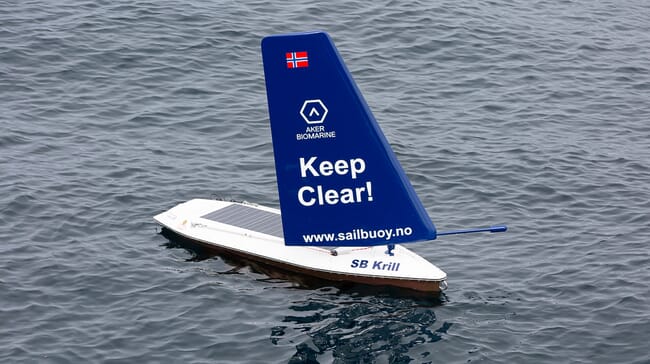Equipped with echosounder and environmental sensors, the two metre long data drone – called the Sailbuoy – collects, processes and transmits density and distribution data from wherever it is deployed, in real time.

© Aker BioMarine
It uses wind for propulsion while the electronics are powered by solar panels, giving it no carbon footprint. Built to be robust and to survive the tough Antarctic conditions, it has also been designed to be small and unobtrusive, so that it does not disturb the local wildlife.
Minimising the need for fishing vessels to spend time and resources looking for krill, the use of the ocean data drone is designed to significantly reduce the financial and environmental costs of the world's largest krill fishing firm.
Frank Grebstad, Aker BioMarine’s SVP of vessel operations says: “Finally deployed, after a number of years in development, the Sailbuoy is changing how we work. We can position it close to the vessel and it will do the searching for us, or we can let it cover remote areas for up to months at a time, telling us where and when to proceed.”
“As our Antarctic eyes and ears, the data the ocean drone is collecting is proving absolutely invaluable, and it is enabling us to make our operations even more sustainable and more focused, further lowering our impact.”
The company behind building the Sailbuoy, Offshore Sensing, is pleased to put the ocean drone in practical use in the tough conditions of Antarctica.
David Peddie, CEO Offshore Sensing says: “Albeit small, the Sailbuoy is designed to make a major impact when it comes to improving efficiency and helping the companies make better decisions based on real-time data. This Sailbuoy will help Aker BioMarine enter a new data-driven era of sustainable fishery.”
Aker BioMarine notes that the data will also benefit the wider scientific community and the krill fishery as whole. The Commission for the Conservation of Antarctic Marine Living Resources (CCAMLR), the international treaty managing the krill fishery in the Southern Ocean, has made decisive steps towards a more dynamic and scientific data driven management regime, which will put a lot of responsibility on the industry’s capability to monitor the krill biomass. The ocean data drone technology will enable the krill management regime of the future to come sooner rather than later.
The CCAMLR biomass survey conducted in 2019 confirms that the krill stock is in a good and healthy condition, having found 62.6 million tonnes of krill in Area 48 with a similar distribution to last time the biomass was surveyed in 2000.



